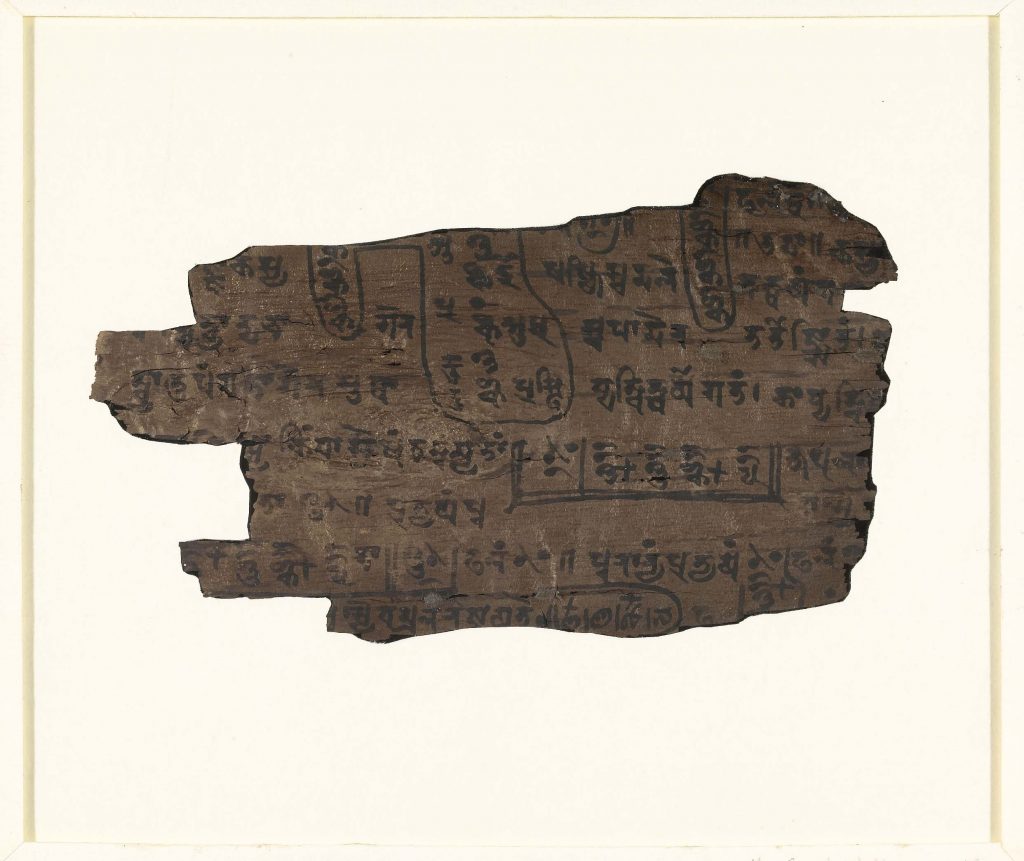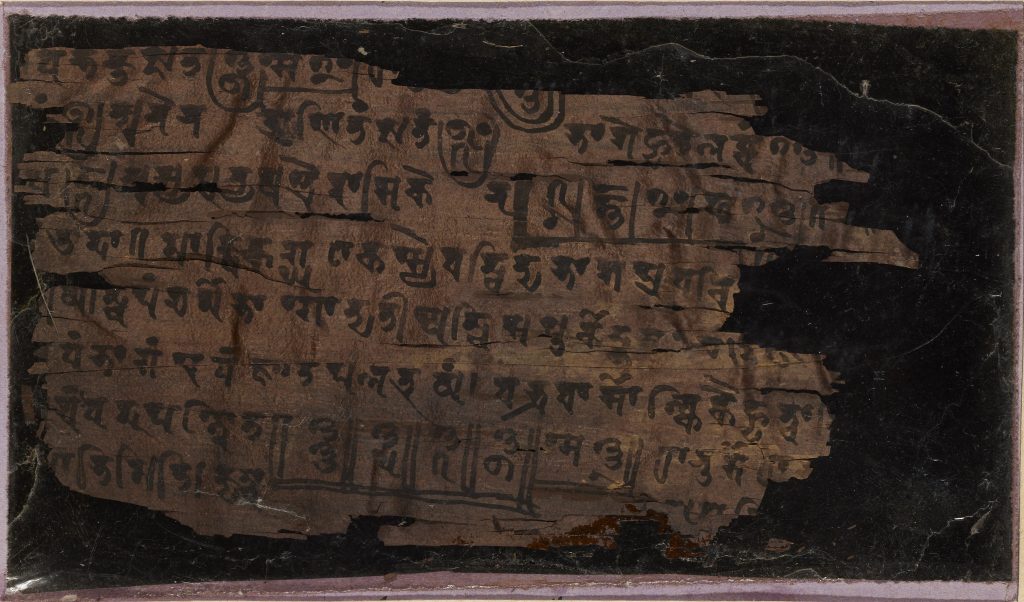The invention of zero, or rather the realisation that it was a number just like any other, was one of the greatest conceptual leaps in the history of mathematics, one that would spur the rise of modern science.
Today it was announced that the written record of zero, in the region which discovered this influential digit, dates back four centuries further than most scholars had thought, thanks to carbon dating of an ancient manuscript, written on 70 leaves of birch bark, held at the University of Oxford’s Bodleian Libraries.
Oxford’s dating project has been surprisingly revealing about the origins of the delicate and fragmented Bakhshali manuscript, one of the star objects in a forthcoming exhibition about Indian science and technology over the past five millennia, that will form part of the Museum’s Illuminating India season from October.

This carbon dating of the manuscript, shows that it is formed of leaves that are nearly 500 years apart in age, with some pages dating from as early as the 3rd to 4th century and others dating from the 8th and 10th centuries.
The field of mathematics provides the logical fabric of modern life – today’s society would falter without zero – so it is hard to imagine a time when zero was, well, zero and mathematics was expressed not by numerals but in verse.
When a written version of zero crystallised from verse in its birthplace in South Asia, it appeared in Sanskrit (not standard Sanskrit, but features of what is called Buddhist Hybrid Sanskrit), as well as other Middle-Indo Aryan languages (Prakrit and Apabhraṃśa) and Old Kashmiri.
Dots in a manuscript, found in a field in 1881 by a farmer in Bakhshali, located near modern Peshawar, Pakistan, mark the earliest written record in the location where zero was first incorporated into the system of numbers we know today, a remarkable moment in the history of mathematics and the development of modern thinking.
Not only is it the only known Indian document on mathematics from such an early period, it also shows all 10 decimal digits which included a dot for zero, and might have been used by Buddhist merchants in trading.
Other ancient peoples were by no means blank when it came to zero: the Babylonians and Mayans realised it was handy to have a placeholder to signal something was absent, using a double wedge or a shell shape.
But in India the symbol grew into a numeral that exists in its own right. You could add it, subtract it, multiply it. Division remains a bit trickier, but that challenge spurred the development of a gloriously strange field of mathematics as these mathematical pioneers wrestled with infinities. By comparison, zero happened with the Babylonian or Mayan placeholder zeroes.
“Why it is so exciting is that this zero in India is the seed from which the concept of zero as a number in its own right, represented by the same dot or circle, will emerge some centuries later, something many regard as one of the of the great moments in the history of mathematics,” comments Marcus du Sautoy, Professor of Mathematics at the University of Oxford.
The age of the Bakhshali manuscript, and thus the dot notation for zero, has been the subject of much scholarly debate. Before this new research, most would say that the manuscript dates back to somewhere between the 8th and 12th century, according to Camillo Formigatti, John Clay Sanskrit Librarian at the Bodleian.
Earlier this year the manuscript was carbon dated for the first time by a team including Formigatti; David Howell, Head of Heritage Science at the Bodleian Libraries; Gillian Evison, Head of the Bodleian Libraries Oriental Section; Virginia Llado-Buisan, Head of Conservation and Collection Care at the Bodleian Libraries and David Chivall, Chemistry Laboratory Manager at the Oxford Radiocarbon Accelerator Unit, which has worked on many significant projects, notably dating the Turin Shroud.
Each sample – between 1.4 mg and 1.8 mg of bark – was taken from an unmarked area of different birch folios. The team measured levels of radioactive carbon-14, compared to stable carbon-12 in each folio, which is continually produced in the upper atmosphere as cosmic rays strike the Earth. Plants and trees incorporate the radiocarbon, in the form of carbon dioxide via photosynthesis and lock up the carbon in their structures, for instance in the birch bark on which the manuscript was written, because radiocarbon decays with a half-life of 5,730 years, once the bark is formed, the amount of radiocarbon within it continually decreases, while the amount of stable carbon remains constant. In this way, the Oxford team could work out how long ago the bark was formed by measuring the ratio of radiocarbon to stable carbon.
The first surprise was that the results reveal that the three samples date from different centuries, one (Folio 33) dated from 885-993 CE, the expected date, but another (Folio 17) dated from 680-779 CE and another (Folio 16) dated from 224-383 CE. That was the biggest surprise of all.
Previous dating methods had been estimated based on the style of writing and the literary and mathematical content and, though a 3rd/4th century date was not totally unprecedented among some scholars, it had not been considered realistic by most of the academic community. The emergence of proto-zero in 200-400 BC comes a long time before the 7th Century, when the astronomer Brahmagupta became the driving force behind zero’s ascendance to greatness. His text, Brahmasphutasiddhanta, The Opening of the Universe, written in 628 CE, is the first to treat zero as a number in its own right and to include a discussion of the arithmetic of zero.
In fact, even more remarkable, the story of zero must date back even further than the Bakhshali manuscript since it is likely a recording of earlier manuscripts, which in turn were based on even earlier verbal representations of mathematics.

Around the time of Christ, scholars in south Asia probably realised the importance of zero and this makes sense because this abstraction thrived on local religious and spiritual beliefs. Jain mathematicians were not intimidated by the idea of the void, or of infinite space, unlike those in the West. The reason is that zero echoed ‘Sunyata’, a Buddhist concept of emptiness.
There was a democratic dimension to this number too: zero gave people power as they could do calculations without the need for an abacus. The story goes that when they did their sums in the sand, early mathematicians came to realise that as they removed stones that represented something, they left a hole behind, which is how we ended up with an empty circle as a zero.
From South Asia, zero migrated into the Middle East, where it was championed by Islamic scholars. In the 8th century the great Arab mathematician al-Khawarizmi adopted it. If only the sixth-century monk, Dionysius Exiguus (“Dennis the Short” from what today is Dobruja, in Romania and Bulgaria), had known about zero when he devised Anno Domini, year of the Lord. By his reasoning, 1 CE immediately followed 1 BC, and his omission of zero would cause much confusion.
Eventually zero arrived in Europe, where it exerted an extraordinary influence. For example, it allowed Isaac Newton in the mid-17th century to invent calculus, which charts change by focusing on “instantaneous” change, changes over tiny intervals that, effectively, are zero.
That is how Newton found that acceleration could be modelled by simple laws of motion. The rise of calculus helped to drive the rise of modern science which in turn has been applied through myriad technologies and generated even more unsettling insights into the nature of zero, not least the ultimate zero, the Big Bang, which saw the birth of space, time and the universe 13.8 billion years ago.
‘The Bakhshali manuscript helps to illustrate how vibrant mathematics has been in India and the east for centuries,’ says Prof du Sautoy. ‘It is also testament to the way mathematics crosses cultural, historical and political boundaries.’
The Professor of Mathematics adds that it is ‘deeply moving to see this dot on an ancient piece of birch bark and recognise how much I have to thank those mathematicians of the past who built the mathematical edifice I now stand on top of.’
Written by Roger Highfield and Matt Kimberley, curator of Illuminating India: 5000 Years of Science and Innovation.
A folio from the Bakhshali manuscript will go on public display at the Science Museum as a centrepiece of the major exhibition Illuminating India: 5000 Years of Science and Innovation, opening 4 October 2017.